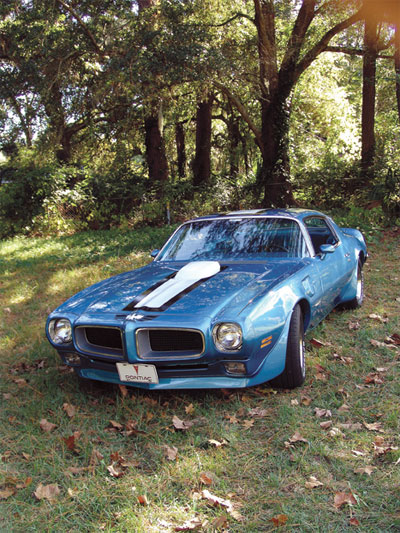1970 Pontiac Trans Am
The second-generation Pontiac Firebird was introduced in February 1970, the late date due to tooling problems. Like its predecessor, customers had a whole grocery list of options that could make their personal ride either mild or wild. Included in the mix was a base model equipped with a 250cid/155hp inline six-cylinder engine, of which only 3,134 were built. Both a three-speed synchromesh gearbox and two-speed automatic were available with the six-cylinder powerplant.
Moving up the option list for those into power included the iron-clad 350cid/250hp 2-bbl. V-8, as well as a 400cid V-8 also fitted with a 2-bbl. carburetor. For those interested in yet a little extra get up and go, the Firebird Formula came standard with a 400cid/265hp V-8, 10.25:1 compression and power running through a three-speed gearbox with a Hurst floor shifter as standard equipment; most customers opted to order the rather sport-less Turbo Hydramatic automatic, however.
Real performance buffs had one more tier on the options list: the highly-touted Trans Am equipped with the L74 Ram Air H.O. 400cid/335hp V-8 equipped with a 4-bbl. carburetor and wide-ratio four-speed gearbox. With 10.5:1 compression, it developed its peak horsepower at 5,000rpm. A total of 3,196 Trans Ams were built that year, 1,769 with the stock Synchromesh four-speed of gearbox. But that wasn’t the end of the road. Those wanting even more muscle checked the box next to the LS1 Ram Air S.D. V-8 that pumped out 345hp. A total of 88 went that route, with 29 keeping with the standard Synchromesh four-speed and 59 ordering the optional Hydramatic.
Factory prices started at $2,875 for the three-speed equipped six-cylinder base model, and with a well-equipped Trans Am, customers could easily double that price. Two color choices of the year were blue with white stripes and white with blue stripes.
One such customer in 1970 was Jim Van DerZee. As a teenager, he worked in the used-car reconditioning department of a small southwestern Michigan Pontiac and Buick dealership. As a car enthusiast, he tried to learn as much as he could about every facet of the automobile business. While he bought used cars and learned how to properly set them up for drag racing at Martin U.S. 131 drag strip, his main interest was having a car in pristine condition. With a penchant for Pontiacs, some of his cars included a 1954 Pontiac Star Chief convertible, 1956 Pontiac Star Chief two-door hardtop, 1958 Pontiac Bonneville convertible, 1964 Pontiac GTO convertible, 1969 Pontiac GTO Judge RA-IV, and the previously-mentioned 1970 Pontiac Trans.
After attending General Motors Institute of Engineering in Flint, Mich., and then graduating with a degree in business from Western Michigan University, Jim started out as a service advisor and service manager, moving on to new-car sales representative and used-car sales manager. He then started a used-car dealership and eventually purchased a small new-car dealership in South Haven, Mich., with franchises for Pontiac and Buick in February 1979. At 29 years old, he was one of the youngest new-car dealers in the country, adding GMC Truck, Cadillac and AMC-Jeep franchises as the years went by, as well as building a state-of-the-art dealership facility. He ran his business successfully for 14 years before selling to a larger dealer from Kalamazoo.
At one point during Jim’s years as a new-car dealer, he needed to raise capital and chose to sell his cherished 1970 Pontiac Firebird RA-IV that he purchased new in July of 1970. The car was sold for a huge amount of money, but he still sadly watched the car as it was loaded onto a fancy bright red, chrome-wheel-equipped enclosed car hauler on its way to California.
When he was financially able, he quickly set out to find another. And he was successful. His current Trans Am looks identical to his first. After receiving paperwork from Pontiac Historical Services and receiving an extensive file on the car’s history, he has determined that the codes and colors are correct as built, including the original engine, carburetor, transmission, rear end, Protect-O-Plate, owners manual and glove-box safety brochures.
The car was originally delivered to a doctor in Miami, and then bought by a retired GM employee who eventually sold it to the man in St. Louis from whom Van DerZee purchased it. The 8-track tape player was a dealer-installed accessory and still works perfectly. The engine has been completely rebuilt, the body was repainted with the correct decal stripes, and the upholstery has been redone. The underbody is very clean and original, and brakes and all mechanicals are in excellent condition. The body is in beautiful condition and has never had any rust.
Van DerZee enjoys the car and keeps it in a climate-controlled garage with a cover over it. It was a class winner in 2003 at the Hilton Head Island Concours d’Elegance and regularly wins at Pontiac club shows and other club events. He drives it at least once a month, as he believes in enjoying his vehicles. Being an original 1970 Trans Am owner for almost 20 years, he can verify that the car performs just as new. Although this Trans Am is equipped with the 400 RA-III and not the 400 RA-IV engine that his first Trans Am had, it does have air-conditioning, which wasn’t even available with the RA-IV.
Van DerZee was fortunate to re-establish and enjoy the 1970 Pontiac Trans Am experience and will continue to preserve, pamper and maintain this great example of a Pontiac performance car. The smooth and sleek William Mitchell styling has held up well through the years and it is quite a pleasant car to drive, even by today’s standards.
West Peterson is editor of Antique Automobile, the official publication of the Antique Automobile Club of America.


